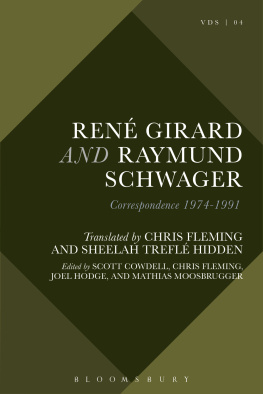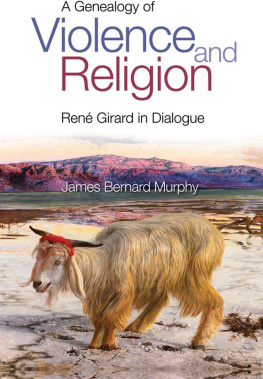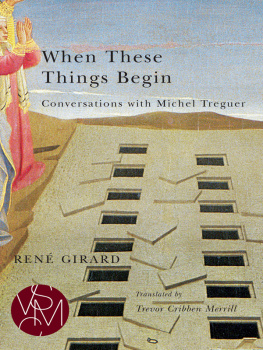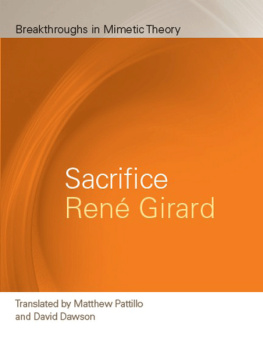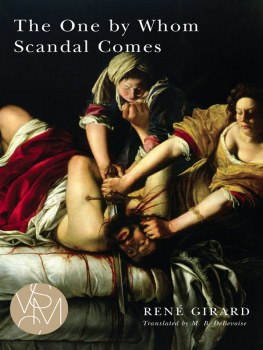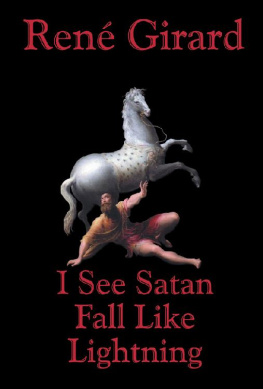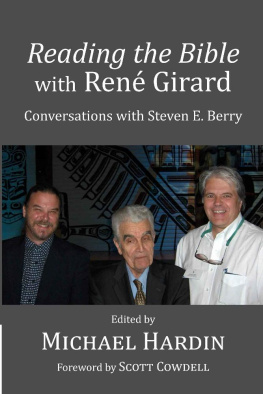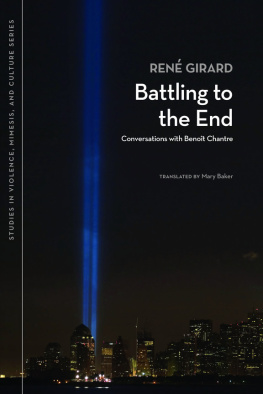Rene Girard and Raymund Schwage - Rene Girard and Raymund Schwage Correspondence
Here you can read online Rene Girard and Raymund Schwage - Rene Girard and Raymund Schwage Correspondence full text of the book (entire story) in english for free. Download pdf and epub, get meaning, cover and reviews about this ebook. year: 0, genre: Religion. Description of the work, (preface) as well as reviews are available. Best literature library LitArk.com created for fans of good reading and offers a wide selection of genres:
Romance novel
Science fiction
Adventure
Detective
Science
History
Home and family
Prose
Art
Politics
Computer
Non-fiction
Religion
Business
Children
Humor
Choose a favorite category and find really read worthwhile books. Enjoy immersion in the world of imagination, feel the emotions of the characters or learn something new for yourself, make an fascinating discovery.
- Book:Rene Girard and Raymund Schwage Correspondence
- Author:
- Genre:
- Year:0
- Rating:4 / 5
- Favourites:Add to favourites
- Your mark:
- 80
- 1
- 2
- 3
- 4
- 5
Rene Girard and Raymund Schwage Correspondence: summary, description and annotation
We offer to read an annotation, description, summary or preface (depends on what the author of the book "Rene Girard and Raymund Schwage Correspondence" wrote himself). If you haven't found the necessary information about the book — write in the comments, we will try to find it.
Rene Girard and Raymund Schwage Correspondence — read online for free the complete book (whole text) full work
Below is the text of the book, divided by pages. System saving the place of the last page read, allows you to conveniently read the book "Rene Girard and Raymund Schwage Correspondence" online for free, without having to search again every time where you left off. Put a bookmark, and you can go to the page where you finished reading at any time.
Font size:
Interval:
Bookmark:


Raymund Schwager (L) and Ren Girard (R), Wiesbaden, 1994 (Photo courtesy of Herlinde Koelbl)
Violence, Desire, and the Sacred
Series Editors:
Scott Cowdell, Chris Fleming, and Joel Hodge
Volumes in the series:
Vol. 1. Girards Mimetic Theory Across the Disciplines
edited by Scott Cowdell, Chris Fleming, and Joel Hodge
Vol. 2. Ren Girard and Sacrifice in Life, Love, and Literature
edited by Scott Cowdell, Chris Fleming, and Joel Hodge
Vol. 3. Mimesis, Movies, and Media
edited by Scott Cowdell, Chris Fleming, and Joel Hodge
Vol. 4. Ren Girard and Raymund Schwager: Correspondence 19741991
edited by Scott Cowdell, Chris Fleming, Joel Hodge, and Mathias Moosbrugger
Vol. 5. Mimesis and Atonement: Ren Girard and the Doctrine of Salvation (forthcoming)
edited by Michael Kirwan SJ and Sheelah Trefl Hidden
Ren Girard and Raymund Schwager
Correspondence 19741991
Edited by
Scott Cowdell, Chris Fleming, Joel Hodge,
and Mathias Moosbrugger
Translated by
Chris Fleming and Sheelah Trefl Hidden
Bloomsbury Academic
An imprint of Bloomsbury Publishing Inc

In Memoriam
Ren Girard, 19232015
Raymund Schwager, SJ, 19352004
Contents
Scott Cowdell is Research Professor in Public and Contextual Theology at Charles Sturt University, Canberra, and Canon Theologian of the Canberra-Goulburn Anglican Diocese. His latest book is Ren Girard and Secular Modernity: Christ, Culture, and Crisis (University of Notre Dame Press, 2013).
Chris Fleming is Senior Lecturer in Philosophy and Anthropology at Western Sydney University. He is the author of Ren Girard: Violence and Mimesis (Polity, 2004).
Joel Hodge is Senior Lecturer in Systematic Theology at Australian Catholic University, Melbourne. He is the author of Resisting Violence and Victimisation: Christian Faith and Solidarity in East Timor (Ashgate, 2012).
Mathias Moosbrugger is a Postdoctoral Researcher in the Department of Systematic Theology at the University of Innsbruck, Austria, where he serves as Coordinator of the Raymund Schwager: Dramatic Theology research project. He is the author of Die Rehabilitierung des Opfers: Zum Dialog zwischen Ren Girard und Raymund Schwager ber die Angemessenheit der Rede vom Opfer im christlichen Kontext (Innsbruck: Tyrolia, 2014).
Karin Peter is a Postdoctoral Researcher and Lecturer in Religious Education at the Department of Practical Theology, University of Vienna, Austria.
Sheelah Trefl Hidden is a Research Associate with the Heythrop Institute for Religion and Society at the University of London. She is the editor of Jewish, Christian, and Islamic Mystical Perspectives on the Love of God (Palgrave Macmillan, 2014) and co-editor of Mimesis and Atonement: Ren Girard and the Doctrine of Salvation ( forthcoming in this series).
Nikolaus Wandinger is Associate Professor for Dogmatic Theology at the Department of Systematic Theology, University of Innsbruck, Austria.
This correspondence provides a window into the formative years of Ren Girards mimetic theory and Raymund Schwagers dramatic theology, in the last quarter of the twentieth century. It takes place between two convinced Catholic intellectuals. The older man was a French-American genius whose powerful synthesis of psychology, culture, and religion impressed and shaped the younger mana Swiss Jesuit theologian, who built a base for developing and commending the mimetic theory at Innsbruck that is still going strong. Not only did Girard influence Schwagers project, which gradually developed into a systematically fully rendered model called dramatic theology, but Schwager was a major influence on Girard as well.
Our volume presents all of the letters that have come to light. The essay Beautiful Minds in Dialogue sets out the provenance of these letters and the story of how a critical edition of the French originals was first published, with parallel German translation. We know that this set of extant letters does not represent the complete correspondence, and you will notice gaps in the flow of communication where some letters are missing. However, what we do have represents a sufficient tranche to establish the strong collaboration, mutual influence, and personal friendship that developed between Girard and Schwager.
In one of his deservedly well-known little treatises on the virtues, German philosopher Josef Pieper wrote that friends do not look at each other as lovers do. They hardly talk about their friendship as such, but focus instead on matters of mutual interest.mimetic theory and theology. It is, above all, the documenting of a very rare thing: real intellectual friendship. Indeed, we have here a model of high-level intellectual exchange that is respectful but does not minimize differences. That said, the letters are also marked by a genuine expression of deepening mutual affection, from the first meeting at Avignon in 1975, to mountain walks in Austria, to Schwagers travels in the United States. What makes the letters exemplary from a scholarly point of view is the fact that, not only are we able to access (more or less clearly) the results of their dialogue in many articles, essays, and books, but we are able to observe the intellectual process. There are real questions, misunderstandings, controversies, and, from both men, a constant willingness to engage in finding answers to vital questions. It is a privilege to observe their ideas in the process of formation.
This correspondence covers the period in which mimetic theory came to be fully articulated for the first time, as set out in Girards and began to wield its influence. The reception was initially marred by incomprehension, resistance, and various practical problems to do with translation and publishing, all of which make for interesting reading. There is a sense that Girard was relying on Schwager as a support and champion for his work, not least in theological circles. The Innsbruck honorary doctorate awarded to Girard in 1988, which his friend labored to bring off, is an important sign of how Schwager saw himself contributing.
A great deal of personal information is contained in the letters, which adds immensely to the picture that emerges of the times in which they were written. Schwager mentions stressful academic politics and Girard the settled happiness of his family life. They reflect ruefully on the plight of theology in general and, in particular, on postconciliar Catholicism both European and American. Both men regard the development of mimetic theory, in which they see themselves very much as collaborators, as of great potential benefit to theology. Nevertheless, Girard is as clear here, as elsewhere, that his eye is on the world and the future, not on any narrow church agenda. There is also some fun to be had at their expense. Both demonstrate the learned helplessness of a generation of male academics whoin their case, for much if not all of the timehad the luxury of secretarial assistance. We eavesdrop when, in the early 1980s, Girard becomes an initially reluctant but soon enthusiastic convert to word processing:
Imagine a typewriter without a fixed spatial reference. You can work at any time on any part of the text, in all directions, add, delete, modify, correct as much as you want, add an entire book to the third line of the first, if that appeals to you, and everything is reformatted and organizes itself right before your eyes . (Girard to Schwager, September 12, 1983)
Font size:
Interval:
Bookmark:
Similar books «Rene Girard and Raymund Schwage Correspondence»
Look at similar books to Rene Girard and Raymund Schwage Correspondence. We have selected literature similar in name and meaning in the hope of providing readers with more options to find new, interesting, not yet read works.
Discussion, reviews of the book Rene Girard and Raymund Schwage Correspondence and just readers' own opinions. Leave your comments, write what you think about the work, its meaning or the main characters. Specify what exactly you liked and what you didn't like, and why you think so.

